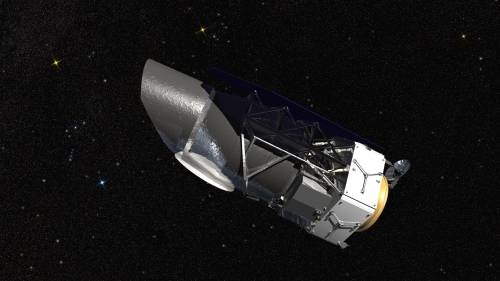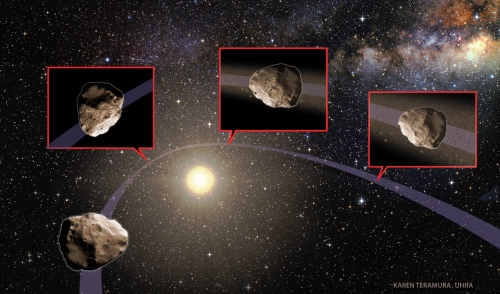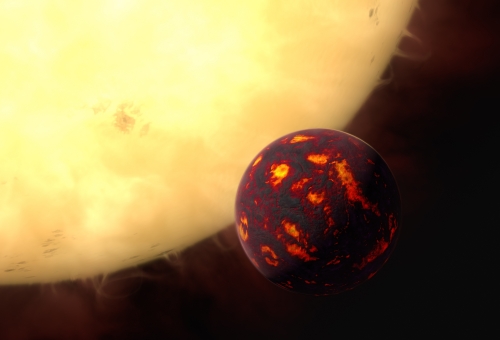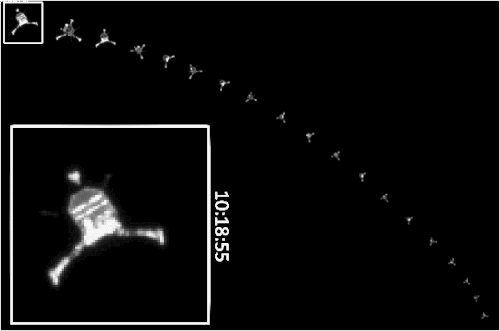Centauri Dreams
Imagining and Planning Interstellar Exploration
Charon: Evidence of an Ancient Ocean
I will admit to a fascination with Pluto’s moon Charon that began even before it was discovered. Intrigued by the most distant places in the Solar System, I had always imagined what the view would be like from a tiny moon circling Pluto. At the time, we didn’t know about Charon, so my vantage point was more like what we now know Kerberos or Styx to be. Then my interest tripled when the sheer size of Charon became known. A large moon was truly a world of its own, and Charon rose in my estimation to rival my other most intriguing moon, Neptune’s Triton.
Now we have word that Charon may once have had an internal ocean, still further evidence of the intricacy of objects in or near the Kuiper Belt. In Charon’s case, something intriguing is shown by a study of the surface, one side of which New Horizons saw during the July 2015 flyby. What appears to be a series of tectonic faults that show up in the form of ridges, scarps and valleys reveals a surface that has to have been stretched over time.
Image: Charon from New Horizons. This image was obtained by the Long-Range Reconnaissance Imager (LORRI) on New Horizons. North is up; illumination is from the top-left of the image. The image resolution is about 394 meters per pixel. The image measures 386 kilometers long and 175 kilometers wide. It was obtained at a range of approximately 78,700 kilometers from Charon, about an hour and 40 minutes before New Horizons’ closest approach to Charon on July 14, 2015. Credit: NASA/Johns Hopkins University Applied Physics Laboratory/Southwest Research Institute.
Remember that on the young Charon, radioactive elements and residual heat from formation could have kept the outer layer of water ice warm enough to melt, creating an ocean beneath the outermost ice crust. Cooling over time would have caused the ocean to freeze and expand, pushing the surface outward to produce the topography New Horizons encountered.
Have another look, then, at the image, which is taken from this JHU/APL news release. At the top right, you can see the feature called Serenity Chasma, which is actually only a part of an equatorial belt of chasms that runs about 1800 kilometers, reaching depths of up to 7.5 kilometers. The lower part of the image provides color-coded topography of the same area. Researchers on the New Horizons team believe the image shows evidence of liquid water that has refrozen over the aeons.
Last spring before the New Horizons flyby I briefly mentioned Stephen Baxter’s “Gossamer.” It’s a short tale in his highly recommended 1997 collection Vacuum Diagrams, following two explorers who have made a forced landing on Pluto only to discover a bizarre form of life that looks like snowflakes. Here’s the relevant bit:
Lvov caught glimpses of threads, long, sparkling, trailing down to Pluto — and up toward Charon. Already, Lvov saw, some of the baby flakes had hurtled more than a planetary diameter from the surface, toward the moon.
“It’s goose summer,” she said.
“What?”
“When I was a kid…the young spiders spin bits of webs, and climb to the top of grass stalks, and float off on the breeze. Goose summer — ‘gossamer.'”
“Right,” Cobh said skeptically. “Well, it looks as if they are making for Charon. They use the evaporation of the atmosphere for life… Perhaps they follow last year’s threads, to the moon. They must fly off every perihelion, rebuilding their web bridge every time…”
Baxter paints a living, interacting system that draws resources from both worlds. Nothing like that in the New Horizons imagery, of course, but plenty of food for thought as we consider the resources of water ice and potential sub-surface oceans even this far from the Sun. Whether any liquid water could survive through the decay of radioactive elements deep within a Kuiper Belt object is debatable, but Charon appears to be showing us what happens when such an ocean finally freezes, its surface ripped apart to create today’s massive chasms.

WFIRST: Moving Closer to a Mission
We learned on Wednesday that the Agency Program Management Council, which works under the aegis of NASA, has made the decision to proceed with the Wide Field Infrared Survey Telescope. WFIRST is the next step in major astrophysical observatories after the launch of the James Webb Space Telescope in 2018, an instrument that will work at near-infrared wavelengths to study dark matter and dark energy, with a significant exoplanet component.
All these issues are relevant to what we do here at Centauri Dreams, but the exoplanet aspect of the mission, which includes a coronagraph to allow the close inspection of distant solar systems, is particularly interesting. Blocking the otherwise overwhelming glare of a host star (even at these wavelengths), the WFIRST coronagraph should help to reveal the planets around it, a crucial separation that will allow us to make spectrographic measurements of the chemical makeup of planetary atmospheres.
Paul Hertz, director of NASA’s astrophysics division in Washington, notes that the instrument responds to the astronomical community’s top priorities for research:
“The Wide-Field Instrument will give the telescope the ability to capture a single image with the depth and quality of Hubble, but covering 100 times the area,” Hertz adds. “The coronagraph will provide revolutionary science, capturing the faint, but direct images of distant gaseous worlds and super-Earths.”

Image: WFIRST, the Wide Field Infrared Survey Telescope, is shown here in an artist’s rendering. It will carry a Wide Field Instrument to provide astronomers with Hubble-quality images covering large swaths of the sky, and enabling several studies of cosmic evolution. Its Coronagraph Instrument will directly image exoplanets similar to those in our own solar system and make detailed measurements of the chemical makeup of their atmospheres. Credit: NASA/Goddard Space Flight Center/Conceptual Image Lab.
The mission will carry a 2.4-meter telescope and will operate at the Lagrangian point L2, about 1.6 million kilometers from the Earth in a direction directly opposite the Sun. Launch is scheduled for the mid-2020s. Monitoring millions of stars in the galactic center, WFIRST is likely to uncover thousands of new exoplanets, following on directly from the phenomenal work of the Kepler mission and the upcoming Transiting Exoplanet Survey Satellite (TESS). The latter takes the exoplanet hunt from the single star-field Kepler used to compile its statistical data and homes in on closer and brighter stars, deepening our catalog of nearby planets.
WFIRST’s roots are in dark energy studies, looking into the negative pressure that is evidently speeding up the expansion of the universe, an issue that can be studied by measuring the distances of thousands of supernovae. As a matter of fact, the mission was first examined in the Decadal Survey of 2010 as primarily a dark energy research telescope, with exoplanet studies via microlensing as no more than a secondary goal. But the donation of two 2.4-meter telescopes to NASA from the National Reconnaissance Office made alterations to the original configuration possible with a primary mirror the same size as the Hubble Space Telescope’s.
The full story of WFIRST’s changing configuration can be found in Ashley Baldwin’s article The Shape of Space Telescopes to Come, which appeared here in 2015 and looked at coronagraph technologies as well as starshades, the latter being large occulting disks that operate as independent spacecraft and are placed between the primary telescope and the star being studied. Exoplanet light comes through as the light of the central star is blocked. The coronagraph WFIRST has wound up with will be delivered from the Jet Propulsion Laboratory.
In his article, Baldwin refers to WFIRST as ‘the first true exoplanet telescope.’ The first, that is, that will be able to see a distant exoplanet as a point source, an instrument capable of direct imaging of exoplanets using its coronagraph while also discovering them through gravitational micro-lensing, where the light of a distant object is bent by the passage of an intervening star and associated planets, allowing one or more planets to be revealed. Planets should turn up in the thousands through transit discoveries as well as astrometry for relatively nearby stars.
WFIRST, in other words, is a mission that has evolved as the various scientific interests have had their say and developed mission concepts for exoplanets, dark energy and dark matter. Although it carries a coronagraph along with its Wide Field Instrument, the space telescope could presumably be rendered ‘starshade-ready’ in hopes of subsequent studies using that method. The success of both the James Webb Space Telescope and WFIRST should have a lot to say about the shape of the coming Decadal Survey that will chart the course after 2020.

Tracking the Chelyabinsk Impactor
Yesterday’s post on the distribution of asteroid populations inevitably had me thinking about the Chelyabinsk event on February 15, 2013, and about the concurrent flyby of the asteroid (367943) Duende, which took place on the same day. A scant sixteen hours after the explosion of the Chelyabinsk bolide and the fall of five tons of meteoritic material to the ground in Siberia, (367943) Duende passed by at about 27,700 kilometers above the surface of the Earth.
We talked yesterday about learning more about asteroid distributions, so we could understand where they come from and what to expect as we assess their trajectories. In the case of Chelyabinsk, it was originally thought that both events were related, with the Chelyabinsk impactor associated with (367943) Duende in the form of a companion object, or perhaps as material that broke away from the parent asteroid. But an analysis of the orbits of both objects as well as spectroscopic analysis of Duende and the Chelyabinsk material says otherwise.
We’re fortunate with Chelyabinsk in having so much data on the object. As this story in Sinc: La ciencia es noticia points out, dashcams are quite popular in Russia, and it is thanks to many of these — along with traffic cameras, security cameras and other sources — that we have a catalog of 960 video recordings. There were many witnesses making manual recordings, and we likewise have plenty of written accounts from those startled by the spectacular event.
All of this has led to calculations of the atmospheric entry trajectory of the object that exploded some 20 kilometers over Siberia, releasing approximately 500 kilotons of energy. The resulting shockwave damaged property out to a distance of 120 kilometers and caused 1491 injuries. At the bottom of Lake Chebarkul divers were able to recover a 650 kg meteorite. So we have plentiful data, allowing researchers to work out different orbital solutions for the parent asteroid.

Image: The Chelyabinsk event as recorded by dashcam north of the city.
Sinc focuses on the work of Carlos and Raúl de la Fuente Marcos who, with Sverre J. Aarseth (University of Cambridge) have searched for the parent body of the Chelyabinsk superbolide. Their work, reported in The Astrophysical Journal finds that the asteroid 2011 EO40 is a dynamically related object, with the Chelyabinsk impactor’s orbit altered because of a close encounter with the Earth in 1982. A trajectory that had paralleled that of 2011 EO40 was transformed into an Earth-crossing path that would strike our planet decades later.
Complicating the analysis is the complexity of the gravitational resonances near the Earth that can cause asteroids of highly different origins to fall into orbits that are relatively similar. The de la Fuente Marcos brothers pursued the investigation in a recent issue of Monthly Notices of the Royal Astronomical Society, where a grouping called 5011 Ptah (named after the only named asteroid in the grouping) is considered as a possible source for Chelyabinsk. From the paper (H stands for absolute magnitude):
This orbital parameter subdomain contains 180 NEOs, the only named object in the list is 5011 Ptah (6743 P-L) although it is not the largest of the group (H = 16.4 mag), 86039 (1999 NC43) is probably larger (H = 16.0 mag); the smallest member of the group is 2002 SQ222 (H = 30.1 mag). Two objects from this group, 86039… and 2011 EO40… have been linked to the Chelyabinsk impactor. Reddy et al. (2015) have pointed out that the existence of a connection between the Chelyabinsk meteoroid and 86039 is rather weak, both in dynamical and compositional terms. Besides there is yet no spectroscopic evidence linking 2011 EO40 to Chelyabinsk. However, the orbit of the actual impactor was almost certainly part of this dynamical grouping…
These are groupings of asteroids that move in similar orbits. They are dynamically but not physically related:
… we have shown statistically that the distribution of the NEO population in orbital parameter space is far from random. We have confirmed the presence of statistically significant dynamical groupings among the NEO population… Some of these dynamical groupings appear to have been the immediate sources of recent asteroid impact events and are likely to continue doing so in the future. The groupings host both relatively large (size between 200 m and 700 m) and very small (a few metres) objects which suggest that some of the smaller fragments may have been produced in situ via rotational instability or other mechanisms… Production of meteoroids within the immediate neighbourhood of the Earth has a direct impact on the evaluation of the overall asteroid impact hazard… However and although this is of considerable theoretical interest, most of these fragments are small enough to be of less concern in practice.
So while we can’t yet pinpoint the origin of the Chelyabinsk impactor, we’re making progress in understanding the various groupings that Near-Earth Objects can fall into. All of this can help us place events like 2008 TC3 in Sudan or 2014 AA in the Atlantic Ocean in context. According to this work, both of these asteroids, which caused no significant damage or injury, belong to the groups the de la Fuente Marcos brothers have analyzed. Studies like these and the ongoing work of projects like the Catalina Sky Survey give us a better sense of the odds of impact and help us prepare in case larger asteroids are found on dangerous trajectories.
The papers are C. de la Fuente Marcos, R. de la Fuente Marcos, S. J. Aarseth. “Chasing the Chelyabinsk asteroid N-body style,” The Astrophysical Journal 812 (October 2015) 26 (abstract). The more recent paper is C. de la Fuente Marcos, R. de la Fuente Marcos. “Far from random: dynamical groupings among the NEO population,” Monthly Notices of the Royal Astronomical Society 456 (3 (March, 2016) 2946-2956 (abstract).

A New Look at Asteroid Distribution
We know that understanding Near-Earth Objects is vital not only for assessing future asteroid surveys and spacecraft missions, but also for tracking potential impactors on Earth. Projects like the Catalina Sky Survey and its now defunct southern hemisphere counterpart, the Siding Spring Survey, are all about asteroid and comet discovery, with a more specific goal of looking for objects posing a potential hazard to our planet. We lost the Siding Spring effort in 2013 due to funding problems, but the Catalina Sky Survey (CSS) is still in robust operation.
The survey draws data from a 1.5 meter telescope on the peak of Mt. Lemmon (Arizona) and a 68 centimeter instrument nearby at Mt. Bigelow. Now we have word that Mikael Granvik (University of Helsinki) and an international team of researchers have drawn on about 100,000 images acquired by the Catalina Sky Survey to study the properties of some 9000 NEOs detected in an eight-year period. The goal is to construct a model for the population of NEOs, giving us better insights into their origins and subsequent trajectories.
Most Near-Earth Objects are thought to originate in the main asteroid belt between the orbits of Mars and Jupiter. An individual asteroid’s orbit can vary over time as heat from the Sun is released from its uneven surface, an effect named after the Russian engineer Ivan Osipovich Yarkovsky, who noted that even this tiny force could have cumulative effects on an asteroid’s orbit. The Estonian astronomer Ernst J. Öpik would subsequently bring the effect to the attention of the larger astronomical community after its initial publication by Yarkovsky.
Asteroid orbits can eventually be affected by the gas giants Jupiter and Saturn, changing their trajectory to push them into the inner system. From this we get our population of NEOs, so classified, according to this University of Hawaii at Manoa news release, when their smallest distance from the Sun during an orbit is less than 1.3 times the average Earth-Sun distance.

Image: Artist’s impression. An asteroid’s orbit is altered as it passes close to Jupiter, Earth or Venus, such that its new orbit takes it near the Sun. The intense heat from the Sun causes the asteroid’s surface to expand and fracture, and some of the material breaks off. As the surface material disintegrates, it creates dust and pebbles that spread out along the asteroid’s orbit with time. If the orbit of the dust and pebbles ever intersects Earth, it can create a meteor shower. Credit: Karen Teramura, UH IfA.
Most NEOs have been thought to eventually end their lives by plunging into the Sun, but now we learn that they may not make it that far. Using calculations developed by Robert Jedicke (University of Hawaii), the Near-Earth Object population modeling project was able to compute the probabilities that asteroids on different orbits would have been detected by the Catalina Sky Survey. Using CSS data and theoretical orbit distributions of NEOs originating in different parts of the main belt, they developed a more detailed model of the NEO population than any previously available.
The model, however, predicted almost ten times more objects on orbits that approach the Sun within ten Solar diameters than have been observed. Eliminating these asteroids could be accomplished by assuming that a large number of NEOs are destroyed as they move closer to the Sun. The asteroids do not fall into the Sun but are broken up as they approach. Darker asteroids are destroyed further from the Sun than brighter ones, implying a different internal structure and composition. Granvik sees this latter as the most significant result of the research:
“Perhaps the most intriguing outcome of this study is that it is now possible to test models of asteroid interiors simply by keeping track of their orbits and sizes. This is truly remarkable and was completely unexpected when we first started constructing the new NEO model.”
The work also helps to explain meteor streams that should follow in the path of the asteroids or comets from which they are dislodged, and yet most meteor streams have not been matched with known objects. The Granvik study concludes that the parent bodies of these meteor streams were destroyed when they approached too close to the Sun.
The paper is Granvik et al., “Super-catastrophic Disruption of Asteroids at Small Perihelion Distances,” Nature 530 (18 February 2016), 303-306 (abstract).

Light, Dry Atmosphere of a ‘Super-Earth’
We’re probing the atmospheres of exoplanets both from the Earth and from space. Transmission spectroscopy allows us to look at the spectra of starlight at various wavelengths as a transiting planet passes first in front of its host star, and then moves behind it. Now we have news of a successful detection of gases in the atmosphere of a super-Earth, using data from the Hubble Space Telescope. The team, made up of researchers at University College London and Catholic University of Leuven (Belgium) calls this a significant first.
“This is a very exciting result because it’s the first time that we have been able to find the spectral fingerprints that show the gases present in the atmosphere of a super-Earth,” said Angelos Tsiaras, a PhD student at UCL, who developed the analysis technique along with colleagues Dr. Ingo Waldmann and Marco Rocchetto in UCL Physics & Astronomy. “Our analysis of 55 Cancri e’s atmosphere suggests that the planet has managed to cling on to a significant amount of hydrogen and helium from the nebula from which it formed.”

Image: This artist’s impression shows the super-Earth 55 Cancri e in front of its parent star. Using observations made with the NASA/ESA Hubble Space Telescope and new analytic software scientists were able to analyze the composition of its atmosphere. It was the first time this was possible for a super-Earth. 55 Cancri e is about 40 light-years away and orbits a star slightly smaller, cooler and less bright than our Sun. As the planet is so close to its parent star, one year lasts only 18 hours and temperatures on the surface are thought to reach around 2000 degrees Celsius. Credit: ESA/Hubble, M. Kornmesser.
55 Cancri, about 41 light years from the Sun, is a binary consisting of a G-class star (55 Cancri A) and an M-class dwarf (55 Cancri B). We know of five planets around 55 Cancri A, the innermost being 55 Cancri e. If you’re worried about the nomenclature, that’s because we could more formally call the planet 55 Cancri Ae, in order to clarify which star the planet orbited in a binary system. All five known planets orbit 55 Cancri A, with 55 Cancri B some 1065 AU out.
Although it is a transiting world, 55 Cancri e and all the other planets in the system were discovered by radial velocity measurements. Temperatures on 55 Cancri e are thought to reach 2000 degrees Celsius on a world whose year is a scant eighteen hours. With a minimum mass of 8.3 M?, the planet has a radius about twice that of the Earth.
Tsiaras and team used the Wide Field Camera 3 (WFC3) on Hubble, retrieving 55 Cancri e’s spectral signature by capturing a number of spectra made with quick scans across the target. The method allows the telescope to slew during the exposure, preventing saturation of the detector. The results were then fed through pipeline software that could remove systematic distortions caused by the scanning method. The paper explains the nature of the correction:
In the case of very long scans, we have to take into account the geometric distortions (dispersion variations across the scanning direction and inclined spectrum) and the positional shifts (horizontal and vertical), as their effect on the structure of the spatially scanned spectrum becomes significant. Especially for fast scans, we found that the vertical shifts are as important as the horizontal ones, because they are coupled with the reading process of the detector (up-stream/down-stream effect), causing exposure time variations. We also found that the time-dependent, long-term systematics, appear to have a different behavior per wavelength channel.
The resulting data show hydrogen and helium in the atmosphere of 55 Cancri e, but no water vapor. There is also an intriguing hint of hydrogen cyanide (HCN) with a possible additional
contribution of other molecules, such as carbon monoxide (CO) , carbon dioxide (CO2) and acetylene (C2H2). HCN is considered to be a marker for carbon-rich atmospheres, which weaves in usefully with what was previously known of the planet. 55 Cancri e has sometimes been called the ‘diamond planet’ because of the possibility that it might have a carbon-rich interior. The current work points in the same direction, with its indication that the planet’s atmosphere has a high ratio of carbon to oxygen.
“If the presence of hydrogen cyanide and other molecules is confirmed in a few years time by the next generation of infrared telescopes, it would support the theory that this planet is indeed carbon rich and a very exotic place,” said Professor Jonathan Tennyson, UCL. “Although, hydrogen cyanide or prussic acid is highly poisonous, so it is perhaps not a planet I would like to live on!”
The paper is Tsiaras et al., “Detection of an Atmosphere Around the Super-Earth 55 Cancri e,” accepted at The Astrophysical Journal (preprint).

Saying Goodbye to Philae
Landing on a small object in the Solar System isn’t easy. Witness the Philae lander, which traveled to Comet 67P/Churyumov-Gerasimenko as part of the European Space Agency’s Rosetta mission. Philae ‘landed’ on November 12, 2014, having to deal with a malfunctioning thruster along the way. Upon arrival at the surface of the comet, Philae was to have fired anchoring harpoons to steady itself on the surface, but after a dramatic seven-hour descent, the harpoons failed to fire.
Thus the lander did touch down at the initial landing site, called Agilkia, but then bounced to a new site — Abydos — about a kilometer away. Even now, we’re not sure just where Philae is despite imagery from the orbiting Rosetta. What ESA has told us, however, is that the lander evidently made contact with the comet four times during an unplanned for two-hour additional flight across the surface. During the process it grazed the rim of a depression called Hatmehit on its way to its resting place at Abydos.

Image: A series of 19 images captured by Rosetta’s OSIRIS camera as the Philae lander descended to the surface of comet 67P/Churyumov-Gerasimenko on 12 November 2014. The timestamp marked on the images are in GMT (onboard spacecraft time).
Credit: ESA/Rosetta/MPS for OSIRIS Team MPS/UPD/LAM/IAA/SSO/INTA/UPM/DASP/ID
I often marvel in these pages at the ability of researchers to pull data out of malfunctioning spacecraft, going back to missions like Mariner 10, which was saved by using its solar panels to steady the spacecraft for all-important navigation fixes. With Philae we see another case of controllers doing everything they can to mitigate a bad situation. In its case, despite a landing that was anything but by the book, the lander completed numerous science measurements even as it bounced along its way to the Abydos site.
We learn in this ESA news release that 80 percent of the initial planned scientific activities were completed despite the bumpy arrival. For 64 hours after the separation from Rosetta, Philae took numerous images from above and on the cometary surface, studying organic compounds and providing data on the surface properties of 67P/Churyumov-Gerasimenko.
You’ll doubtless remember the rest: The lander was receiving insufficient sunlight to charge its secondary batteries, making data collection a race against the clock while the primary battery drained. Philae lapsed into hibernation on the 14th of November, 2014, though controllers had hopes that as the comet moved toward perihelion in August of 2015, the lander might awaken. And indeed on June 13, Philae resumed telemetry transmissions, with data showing that it had actually come back to life on April 26 but had not been able to send signals until June 13.
Contact with Philae in following weeks included seven intermittent links with Rosetta, the last coming on the 9th of July. Rosetta itself had to back off from 67P/Churyumov-Gerasimenko because of increased gas and dust activity as the comet warmed. Recently the activity levels have fallen enough to allow Rosetta to close to within 45 kilometers, but despite repeated passes over the landing area, no subsequent signal from Philae has been detected.
“The comet’s level of activity is now decreasing, allowing Rosetta to safely and gradually reduce its distance to the comet again,” says Sylvain Lodiot, ESA’s Rosetta spacecraft operations manager. “Eventually we will be able to fly in ‘bound orbits’ again, approaching to within 10-20 km – and even closer in the final stages of the mission – putting us in a position to fly above Abydos close enough to obtain dedicated high-resolution images to finally locate Philae and understand its attitude and orientation.”

Image: Using the CIVA camera on Rosetta’s Philae lander, the spacecraft snapped a ‘selfie’ at comet 67P/Churyumov-Gerasimenko from a distance of about 16 km from the surface of the comet. The image was taken on 7 October and captures the side of the Rosetta spacecraft and one of Rosetta’s 14 m-long solar wings, with 67P/C-G in the background. Two images with different exposure times were combined to bring out the faint details in this very high contrast situation. The active ‘neck’ region of 67P/C-G is clearly visible, with streams of dust and gas extending away from the comet. Credits: ESA/Rosetta/Philae/CIVA.
Hopes of contacting the lander have faded given conditions on the surface, where dust may well be covering Philae’s solar panels. Moreover, there is no reason to think that Philae is in the same orientation or even location that it was in November of 2014, given the outflows of gas and dust the comet experienced last summer. Now 350 million kilometers from the Sun and on its way back out toward the outer system, the comet is at temperatures below the lander’s ability to operate.
Rosetta, despite all this, will keep listening for signals all the way in as it moves toward the comet for a landing in September. The odds get longer with each passing day:
“The chances for Philae to contact our team at our lander control centre are unfortunately getting close to zero,” says Stephan Ulamec, Philae project manager at the German Aerospace Center, DLR. “We are not sending commands any more and it would be very surprising if we were to receive a signal again.”



